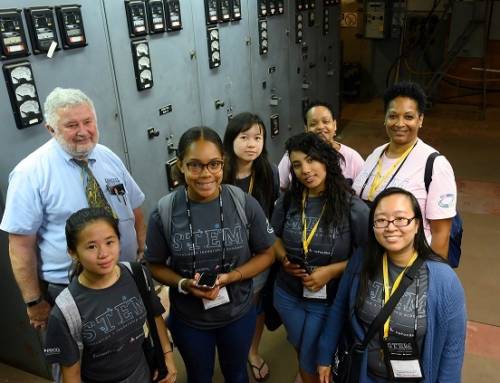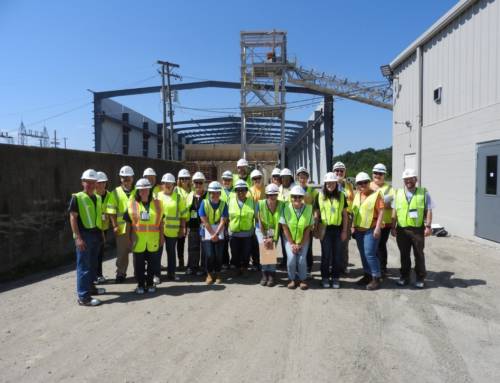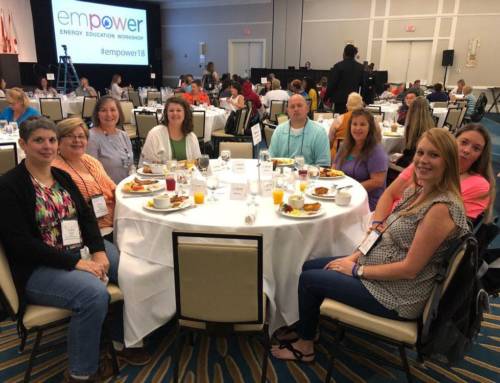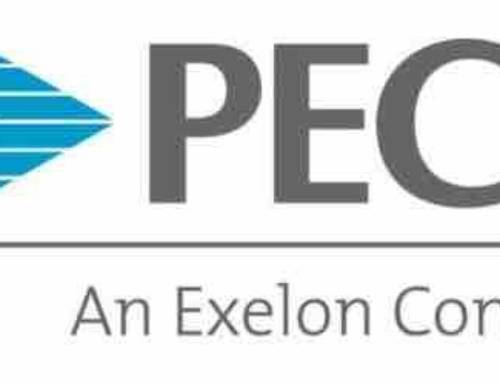U.S. Department of Education’s Green Ribbon Schools Best Practices Tour Itinerary Includes Four Kentucky NEED Schools
On August 20 and 21, national and state dignitaries, educators, school officials, and many others had the opportunity to tour some of the nation’s finest Green Ribbon Schools in Kentucky as part of the national tour of the U.S. Department of Education Green Ribbon Schools program. Four of the five schools visited are NEED schools! These fantastic NEED students led tours of their school and shared the many things they’ve learned about energy, the environment and their school as participants in our Kentucky NEED program.
The tour kicked off at 2013’s Green Ribbon School, Northern Elementary in Scott County, Kentucky. When energy was first assessed at Northern Elementary, it was found to be the district’s least efficient and lowest energy performing school, due to the age, lack of programming, and little school ownership in energy management. With buy-in and lots of hard work, the staff, students, and supporters from the community, NEED, state organizations, and beyond, Northern Elementary became the district’s most efficient and highest performing school. Achieving the Energy Star Award in 2012, Northern Elementary had an Energy Star Rating of 84, which was an over 42% reduction compared to their 2010 baseline. Energy Manager Jim McClanahan got the ball rolling and made this school and energy savings a priority. Elizabeth Cook, the school’s energy champion and team leader spearheaded the challenge with her 4th grade energy team. Using The NEED Project’s curriculum, tools, trainings, and recognition incentives, Mrs. Cook and her energy team continued to learn, assess, and make changes. By measuring the energy use, light output, daily practices of shutting off computers, turning off lights, getting rid of mini-fridges, and numerous other assessments, the school was able to achieve Green Ribbon status. The lesson learned was that with hard work and dedication you can turn an old, inefficient school, into one that can compete with the newest and most energy efficient schools in the nation.
As part of their community outreach, Northern Elementary students traveled to the neighboring community of Sadieville, where they assessed the energy usage at the courthouse and police station. The students then followed up weeks later with recommendations on how the city could save money. The students applied for and received funding to plan and facilitate their project through Kentucky NEED’s partnership with LG&E/KU.
The next stop on this Kentucky tour was Georgetown Middle School, a 54 year old building. A school that is right in the center of Georgetown, this school had motivation to go green and be the pride of the city. Dr. Gayla Thompson leads one of the best energy teams in the state and her students took the initiative to make find the problem and make changes that would improve not only the school, but the community. Also using The NEED Projects curriculum and tools, students from GMS went to two local elementary schools and to community facilities to educate others on the values of going green. Compared to their 2010 baseline, GMS reduced its annual greenhouse gas emissions by 20 percent. The school also installed an underground retention system to help prevent runoff and improve the quality of the school’s water supply. These students also lead 43 teachers through the Science of Energy stations at The NEED Project’s annual professional development workshop in Georgetown. The students got rave reviews from the teachers, and the challenge was made for the teachers to try to stump the students with questions. The participating teachers were 100% unsuccessful! Georgetown Middle School is another shining example of a low-performing school that has been made significantly more efficient through improved practices and routines thanks to the hard work of the student energy team, district support, community partners, and other organizations.
After touring Georgetown Middle School, participants in the Green Ribbon Schools Best Practices Tour had the opportunity to tour a local company, Big Ass Solutions. Headquartered in Lexington, Kentucky, Big Ass Solutions designs, creates, constructs, sells, services, and installs the most innovative fans of all sizes and applications in the world. They also sell lighting technologies for many applications, like schools. Big Ass Solutions was the site for the tour’s Listening Session where a round-table discussion was held. The theme for the discussion was Healthy Schools, High-Achieving Students Facilities Best Practices Tour: Spotlighting Healthy, Safe and Sustainable Schools. The facility of Big Ass Solutions was very unique, with employee amenities that rival few in the state. With 650 current employees, 80% of this workforce comes from Kentucky and almost 79% came from The University of Kentucky. Workers for Big Ass Solutions carry degrees from all over the board, whereas the company looks for simply for talent and knows that no matter the degree or background, they will utilize it. Big Ass Solutions offers great opportunities for schools to improve efficiency by installing these state of the art fans as an alternative to air conditioning systems. They just completed major installations in California and South Carolina. In the school market, the fans are simply referred to as Big A fans.
Day 2 of the tour began at one of Kentucky’s 2012 Green Ribbon Schools, Rosa Parks Elementary in Lexington, Ky. Rosa Parks is another example of improving an older existing school and boasts another one of the state’s hardest working Student Energy Teams. They’ve installed rain barrels and walking trails, and planted trees. As one of the two sustainability pilot schools for Fayette County Public Schools, Rosa Parks earned the Energy Star Award in 2011 because they reduced their energy consumption by more than 40 percent compared to a 2009 baseline. Active in The NEED Project’s teacher workshops, Youth Awards Program, and curriculum, use of NEED’s hand-on kits allowed Rosa Parks to be another hit on the Green Ribbon Schools Tour.
Next stop on day two was one of Kentucky’s most active NEED schools, Wellington Elementary, also in Fayette County. Built in 2010, Wellington Elementary was designed to be one of the most energy efficient and sustainable schools in the state. NEED students led the tour sharing the many features of this school that included solar panels, rainwater capture system, permeable pavers, a rain garden, native landscape, automatic lighting controls, and an outdoor classroom. Wellington also has a student and teacher led sustainability team that monitors and holds the school accountable for their lofty initiatives. Every classroom recycles as well as makes sure their lights, computer monitors, overhead projectors, and any other energy-wasting appliances are turned off when not in use.
The final stop on this very exciting 2-day tour was the Locust Trace Agri-Science Farm, in Fayette County. This is the district’s newest career and technical high school with energy and environment being the key factors of the facility design while agriculture is the educational focus. This school sits on 82 acres. They have large classrooms that accommodate the numerous curriculum specialties that include a fully functional veterinary clinic, machinery tech, consumer sciences, 6.5 acres for gardening, state-of-the-art green house and aquaculture area, an expansive equine barn and arena, and a huge auditorium. This school is used for many district events, trainings, outreach, and education opportunities. Designed to be net-zero, the school uses solar thermal for water heating and photovoltaics for electricity. They also reduce rain water run-off through the use pervious pavement and constructed wetlands. Rain water on the large equine barn and classroom buildings is collected and used to irrigate crops and water livestock. As one of the most unique schools in the nation, Locust Trace was a perfect ending to an exciting tour of Kentucky’s most innovative and energy efficient schools.





